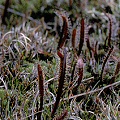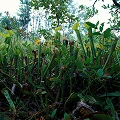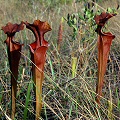Q: How are carnivorous plants doing in the wild?
A: In the USA, wetlands are almost completely gone, having been
transformed by human hands into agriculture, housing, business, and infrastructure. Only 3-5% of carnivorous plant habitat
remains, so the plants are in desperate trouble. There are some preservation attempts
being made, but even if completely successful will only save a few remnant and fragmented
stands.
A problem which is
becoming more obvious is that the use of Sphagnum and peat moss by the nursery
trade (including carnivorous plant growers) supports a large industry of mining peat from bogs.
This non-sustainable industry is gobbling up the last of our peat bogs.
Once a population of plants is greatly damaged, so that only relatively few
number of specimens remain, poaching becomes a significant problem. Poaching
is a significant threat to rare pitcher plants (i.e. Sarracenia
and Nepenthes).
Overseas, things are just as bad. Some of the most flamboyant
carnivorous plants such as Nepenthes live in the jungles of Malaysia and nearby
islands, where slash and burn agriculture threatens them with extinction.
Many species are already extinct.
The values of
wetlands (as natural water treatment facilities and flood prevention sponges)
are not recognized, and so are frequently "developed" (drained). Many of these
issues can be addressed by letting your elected politicians know that you care about
protecting the few sites that are left.
Page citations: Rice, B.A. 2006a;
Schnell, D.E. 2002a; Simpson, R.B. 1994; C. Lee, private communication;
personal observation; reader contributions.


